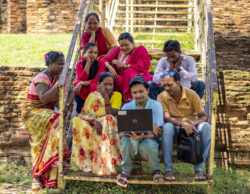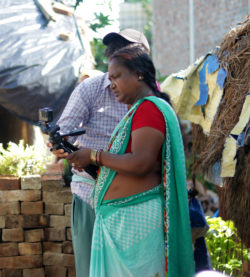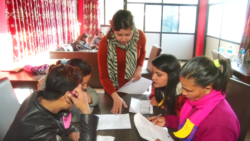The Power of Community to Combat AMR
Written by Basudev Bhattarai, edited by Nichola Jones
 In this blog, Basudev Bhattarai (HERD International Intervention Coordinator) will share reflections on how community members from two wards in the Kapilvastu district of Nepal were able to tell stories from their own communities and what could be the possible impacts of their works.
In this blog, Basudev Bhattarai (HERD International Intervention Coordinator) will share reflections on how community members from two wards in the Kapilvastu district of Nepal were able to tell stories from their own communities and what could be the possible impacts of their works.
As part of the COSTAR project, we have been conducting Participatory Video (PV) workshops in in Kapilvastu district of Lumbini Province in Nepal. In these workshops, community members used video to share their stories on interactions between people and antimicrobials based on their knowledge and experience.
From ‘impossible’ to possible
Initially when we approached to the community members, they had expression of doubt about their ability to make the films. As an Intervention Coordinator, I was in-charge of implementing field-level activities for two participatory workshops and showcasing events. After the selection of participants, we organized the workshops where we introduced AMR, shared different issues revolving around appropriate use of antimicrobials and consequences of improper use of antimicrobials. We also shared some basic skills of video making, scripting, and filming. After participating in the 5-days workshops, the participants filmed their short videos themselves in their setting by identifying the subject matter existing in the community. The films produced by the participants were edited by members of the HERD International team. During the conversation with us in the first day of the first workshop, some of the participants had  said it looked like ‘impossible’ for them to make the video. However, at the end of workshop on day five, all the participants expressive to talk about AMR and turned excited to make the video stories.
said it looked like ‘impossible’ for them to make the video. However, at the end of workshop on day five, all the participants expressive to talk about AMR and turned excited to make the video stories.
A much- awaited day
Following the workshops, community members from both wards had put a lot of efforts in conceptualising, scripting, acting and shooting, the tasks which they never did before. They had both fear and excitation. When final video stories were prepared with support from our audio-visual team, participants from ward number 9 scheduled video premier on 23 August 2022 and participants from ward number 2 scheduled premier on 2 September 2022. All of the invitees' lists for the event were prepared by the participants. The PV participants had invited policy makers and people from different walk of life across human, animal and environmental health sectors. These included; community people, farmers, medical owners, farm owners, agro-vet owners, health workers, representatives from different divisions like human health, animal health, education, WASH divisions, and veterinary officers.
 Attendees of showcasing events curiously watched the films. This event was managed by the PV workshop participants themselves with some assistance from the HERD team. A participant on the premier event organized on 2 September said during ‘vote of thanks’ remarks that the much-awaited day was over today as she feel empowered after participating in the participatory video making.
Attendees of showcasing events curiously watched the films. This event was managed by the PV workshop participants themselves with some assistance from the HERD team. A participant on the premier event organized on 2 September said during ‘vote of thanks’ remarks that the much-awaited day was over today as she feel empowered after participating in the participatory video making.
Challenges and learning
As part of community-based intervention, we had to form groups for participatory video making on AMR. Initially this was a bit challenging. Identifying community members, securing their interest to join the workshop and forming the groups required rounds of consultations with municipal officials and elected leaders specially ward offices and ward chairs. Support from ward chairs and representatives and selection of local facilitators helped us identify the participants as per our criteria. Participants were from different sectors, which made it challenging to get them together at the same time and place. Setting up flexible time and location for workshop and their availability helped things to smoothly. We had also thought that it would be difficult familiarising the participants with camera and making them speak in from of camera. However, as we closely worked with them, they turned spontaneous and vocal in playing different roles. The use of local languages made stories to clearly understandable to the local people.
 After the showcasing films, the participants expressed that the entire process made them clear about proper use of antimicrobials and also enhanced their confidence to tell their experience in front of cameras and large groups. A series of efforts and engagement of community participants ended with drawing the attention of local level policy makers such as mayor and ward chairs of the municipality. While speaking in the screening event, chief administrator of the municipality said he was amazed to see the stories on AMR produced by the community members and expressed commitment that the municipality would consider the issues shown in the video while dealing with municipal policies and programs.
After the showcasing films, the participants expressed that the entire process made them clear about proper use of antimicrobials and also enhanced their confidence to tell their experience in front of cameras and large groups. A series of efforts and engagement of community participants ended with drawing the attention of local level policy makers such as mayor and ward chairs of the municipality. While speaking in the screening event, chief administrator of the municipality said he was amazed to see the stories on AMR produced by the community members and expressed commitment that the municipality would consider the issues shown in the video while dealing with municipal policies and programs.
I realized that even a short training and little technical guidance can increase the power of the community. And their engagement can become instrumental to address the drivers of AMR at community level.
